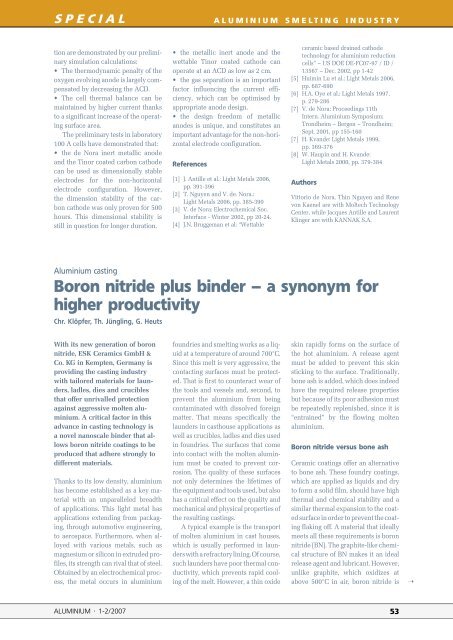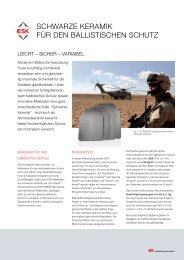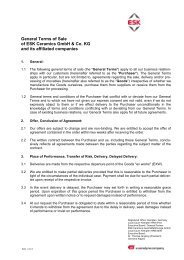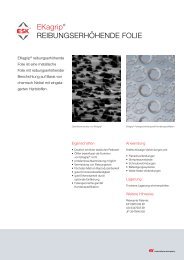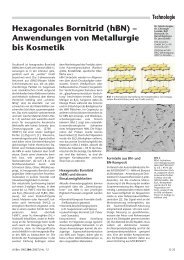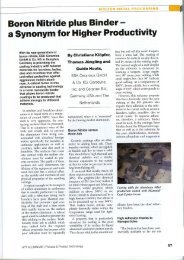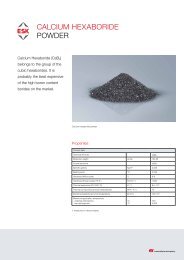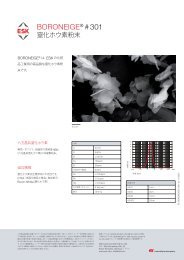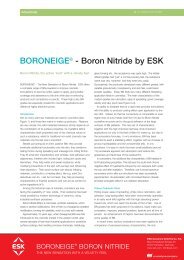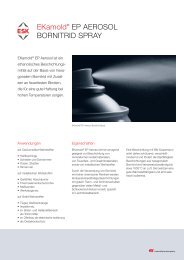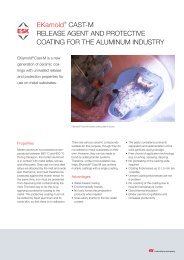Boron nitride plus binder â a synonym for higher productivity
Boron nitride plus binder â a synonym for higher productivity
Boron nitride plus binder â a synonym for higher productivity
Create successful ePaper yourself
Turn your PDF publications into a flip-book with our unique Google optimized e-Paper software.
SPECIAL<br />
tion are demonstrated by our preliminary<br />
simulation calculations:<br />
• The thermodynamic penalty of the<br />
oxygen evolving anode is largely compensated<br />
by decreasing the ACD.<br />
• The cell thermal balance can be<br />
maintained by <strong>higher</strong> current thanks<br />
to a significant increase of the operating<br />
surface area.<br />
The preliminary tests in laboratory<br />
100 A cells have demonstrated that:<br />
• the de Nora inert metallic anode<br />
and the Tinor coated carbon cathode<br />
can be used as dimensionally stable<br />
electrodes <strong>for</strong> the non-horizontal<br />
electrode configuration. However,<br />
the dimension stability of the carbon<br />
cathode was only proven <strong>for</strong> 500<br />
hours. This dimensional stability is<br />
still in question <strong>for</strong> longer duration.<br />
ALUMINIUM SMELTING INDUSTRY<br />
• the metallic inert anode and the<br />
wettable Tinor coated cathode can<br />
operate at an ACD as low as 2 cm.<br />
• the gas separation is an important<br />
factor influencing the current efficiency,<br />
which can be optimised by<br />
appropriate anode design.<br />
• the design freedom of metallic<br />
anodes is unique, and constitutes an<br />
important advantage <strong>for</strong> the non-horizontal<br />
electrode configuration.<br />
References<br />
[1] J. Antille et al.: Light Metals 2006,<br />
pp. 391-396<br />
[2] T. Nguyen and V. de. Nora.:<br />
Light Metals 2006, pp. 385-390<br />
[3] V. de Nora: Electrochemical Soc.<br />
Interface - Winter 2002, pp 20-24.<br />
[4] J.N. Bruggeman et al: “Wettable<br />
ceramic based drained cathode<br />
technology <strong>for</strong> aluminium reduction<br />
cells” – US DOE DE-FC07-97 / ID /<br />
13567 – Dec. 2002, pp 1-42<br />
[5] Huimin Lu et al.: Light Metals 2006,<br />
pp. 687-690<br />
[6] H.A. Oye et al.: Light Metals 1997,<br />
p. 279-286<br />
[7] V. de Nora: Proceedings 11th<br />
Intern. Aluminium Symposium;<br />
Trondheim – Bergen – Trondheim;<br />
Sept. 2001, pp 155-160<br />
[7] H. Kvande: Light Metals 1999,<br />
pp. 369-376<br />
[8] W. Haupin and H. Kvande:<br />
Light Metals 2000, pp. 379-384<br />
Authors<br />
Vittorio de Nora, Thin Nguyen and Rene<br />
von Kaenel are with Moltech Technology<br />
Center, while Jacques Antille and Laurent<br />
Klinger are with KANNAK S.A.<br />
Aluminium casting<br />
<strong>Boron</strong> <strong>nitride</strong> <strong>plus</strong> <strong>binder</strong> – a <strong>synonym</strong> <strong>for</strong><br />
<strong>higher</strong> <strong>productivity</strong><br />
Chr. Klöpfer, Th. Jüngling, G. Heuts<br />
With its new generation of boron<br />
<strong>nitride</strong>, ESK Ceramics GmbH &<br />
Co. KG in Kempten, Germany is<br />
providing the casting industry<br />
with tailored materials <strong>for</strong> launders,<br />
ladles, dies and crucibles<br />
that offer unrivalled protection<br />
against aggressive molten aluminium.<br />
A critical factor in this<br />
advance in casting technology is<br />
a novel nanoscale <strong>binder</strong> that allows<br />
boron <strong>nitride</strong> coatings to be<br />
produced that adhere strongly to<br />
different materials.<br />
Thanks to its low density, aluminium<br />
has become established as a key material<br />
with an unparalleled breadth<br />
of applications. This light metal has<br />
applications extending from packaging,<br />
through automotive engineering,<br />
to aerospace. Furthermore, when alloyed<br />
with various metals, such as<br />
magnesium or silicon in extruded profiles,<br />
its strength can rival that of steel.<br />
Obtained by an electrochemical process,<br />
the metal occurs in aluminium<br />
foundries and smelting works as a liquid<br />
at a temperature of around 700°C.<br />
Since this melt is very aggressive, the<br />
contacting surfaces must be protected.<br />
That is first to counteract wear of<br />
the tools and vessels and, second, to<br />
prevent the aluminium from being<br />
contaminated with dissolved <strong>for</strong>eign<br />
matter. That means specifically the<br />
launders in casthouse applications as<br />
well as crucibles, ladles and dies used<br />
in foundries. The surfaces that come<br />
into contact with the molten aluminium<br />
must be coated to prevent corrosion.<br />
The quality of these surfaces<br />
not only determines the lifetimes of<br />
the equipment and tools used, but also<br />
has a critical effect on the quality and<br />
mechanical and physical properties of<br />
the resulting castings.<br />
A typical example is the transport<br />
of molten aluminium in cast houses,<br />
which is usually per<strong>for</strong>med in launders<br />
with a refractory lining. Of course,<br />
such launders have poor thermal conductivity,<br />
which prevents rapid cooling<br />
of the melt. However, a thin oxide<br />
skin rapidly <strong>for</strong>ms on the surface of<br />
the hot aluminium. A release agent<br />
must be added to prevent this skin<br />
sticking to the surface. Traditionally,<br />
bone ash is added, which does indeed<br />
have the required release properties<br />
but because of its poor adhesion must<br />
be repeatedly replenished, since it is<br />
“entrained” by the flowing molten<br />
aluminium.<br />
<strong>Boron</strong> <strong>nitride</strong> versus bone ash<br />
Ceramic coatings offer an alternative<br />
to bone ash. These foundry coatings,<br />
which are applied as liquids and dry<br />
to <strong>for</strong>m a solid film, should have high<br />
thermal and chemical stability and a<br />
similar thermal expansion to the coated<br />
surface in order to prevent the coating<br />
flaking off. A material that ideally<br />
meets all these requirements is boron<br />
<strong>nitride</strong> (BN). The graphite-like chemical<br />
structure of BN makes it an ideal<br />
release agent and lubricant. However,<br />
unlike graphite, which oxidizes at<br />
above 500°C in air, boron <strong>nitride</strong> is ➝<br />
53 ALUMINIUM · 1-2/2007<br />
ALUMINIUM · 1-2/2007 53
ALUMINIUM SMELTING INDUSTRY<br />
Casting table <strong>for</strong> aluminum billet production coated with<br />
EKamold Cast-C prior to use<br />
Casting table <strong>for</strong> aluminum billet production coated with<br />
EKamold Cast-C after use<br />
SEM picture of a cross section of EKamold Cast-C Coating<br />
characterized by a high thermal stability<br />
that allows it to be processed<br />
up to over 900°C. That makes boron<br />
<strong>nitride</strong> completely thermally stable in<br />
the temperature range used <strong>for</strong> lightmetal<br />
casting.<br />
A property that is particularly attractive<br />
<strong>for</strong> casting is the poor wettability<br />
of its surface by liquid aluminium<br />
and other molten metals. They<br />
do not stick to the smooth surface<br />
but roll off like water droplets from a<br />
lotus leaf. The wetting of ceramics by<br />
melts is usually described by means of<br />
the wetting angle. The contact angle<br />
All photos: ESK<br />
of a melt droplet on the substrate is<br />
measured by <strong>for</strong>ming a tangent. Large<br />
angles over 90° mean poor wetting,<br />
while small angles less than 90° indicate<br />
good wetting. At a temperature<br />
of 900°C, boron <strong>nitride</strong> has a wetting<br />
angle of 160°, which corresponds to<br />
poor wetting.<br />
However, this welcome property<br />
also has a downside, since the poor<br />
wetting of the BN platelets also impairs<br />
their adhesion to the substrates<br />
to be coated, such as ceramic launders,<br />
ladles, crucibles, dies or metal<br />
moulds. To improve adhesion, there<strong>for</strong>e,<br />
a refractory <strong>binder</strong> must be used.<br />
In the coatings, these <strong>binder</strong>s bond<br />
the BN particles together as well as<br />
to the substrate. In the past, phyllosilicates,<br />
monoaluminium phosphate<br />
and magnesium silicate have been the<br />
chief refractory <strong>binder</strong>s.<br />
High adhesion thanks to nanoparticles<br />
“The <strong>binder</strong>s that have been commercially<br />
available so far are not ideal <strong>for</strong><br />
the casting industry,” says Christiane<br />
Klöpfer of the technical marketing<br />
department at ESK. A major disadvantage<br />
is that they are only suitable<br />
<strong>for</strong> applying thin coatings, since otherwise<br />
the rapid temperature cycles<br />
could cause them to flake off. “In<br />
looking <strong>for</strong> improved high-temperature<br />
<strong>binder</strong>s, we hit on sol-gel systems<br />
rein<strong>for</strong>ced with nanoscale particles,”<br />
explains Klöpfer.<br />
The patented <strong>binder</strong> system, as a<br />
BN coating <strong>for</strong> the casting industry, is<br />
called EKamold Cast-C, and is a real<br />
innovation <strong>for</strong> high-temperature applications.<br />
The system develops its effect<br />
in situ when heat treated during<br />
the first casting cycle, similar to twopack<br />
adhesives, and <strong>for</strong>ms a film that<br />
is resistant to both heat and abrasion.<br />
Compared to conventional boron <strong>nitride</strong>-based<br />
coatings, this product innovation<br />
offers unrivalled durability<br />
together with ease of application and<br />
extremely low requirements on the<br />
substrate.<br />
Coatings can be repaired<br />
There are also processing advantages<br />
to using boron <strong>nitride</strong> (BN). For ex-<br />
ample, BN coatings can be applied<br />
by spraying, brushing or dipping.<br />
Although BN coatings develop their<br />
protective effect at a few microns<br />
thickness, the new BN foundry coatings<br />
from ESK can be applied in<br />
thicknesses up to 1 mm. That means<br />
the coating can be readily applied by<br />
untrained staff. The new coating can<br />
be used wherever liquid aluminium is<br />
processed. The range of applications<br />
extends from compact aluminium<br />
ingots to aluminium car wheels and<br />
engine blocks.<br />
Furthermore, the new BN coatings<br />
developed by ESK, <strong>for</strong> the first time<br />
ever, allow damaged coatings and<br />
cracks in the substrate to be repaired.<br />
In the traditional process, if the coatings<br />
were damaged, they had to be<br />
painstakingly removed and then reapplied.<br />
With the new systems, damaged<br />
areas of the coating can be repaired<br />
– e.g. with a brush. More ov er, the<br />
coatings can seal cracks and chipping<br />
in the substrate by infiltrating them.<br />
No sedimentation thanks to<br />
„thixotropy“<br />
“Traditional” BN coatings generally<br />
had the problem of sedimentation of<br />
the BN solid particles, and had to be<br />
very carefully stirred to prevent settling<br />
out, which would change the<br />
properties. The new ESK coating<br />
offers a further advantage, since, although<br />
it becomes gel-like after standing<br />
<strong>for</strong> a long time, it can be easily liquefied<br />
again by stirring or shaking – a<br />
property known as “thixotropy.” “All<br />
these completely new possibilities<br />
offer major advantages to users,” enthuses<br />
Thomas Jüngling, Chief Technology<br />
Officer of the Cali<strong>for</strong>nia-based<br />
Ceradyne Inc. Cast houses and foundries<br />
are harsh environments, where<br />
users must be able to depend on the<br />
materials used operating flawlessly.<br />
“The casting industry is very interested<br />
in the new boron <strong>nitride</strong> coatings,”<br />
observes Jüngling. The new coatings<br />
have already been subjected to practical<br />
tests in aluminium foundries.<br />
<strong>Boron</strong> <strong>nitride</strong> coatings last longer …<br />
Guido Heuts of the Dutch company<br />
Ceranex, a supplier of heat-resistant<br />
54 ALUMINIUM · 1-2/2007
SPECIAL<br />
ALUMINIUM SMELTING INDUSTRY<br />
Why <strong>Boron</strong> <strong>nitride</strong> has similar properties to graphite<br />
<strong>Boron</strong> <strong>nitride</strong>, a synthetic substance with the<br />
chemical <strong>for</strong>mula BN, is a sort of “inorganic<br />
carbon”. That means BN’s chemical and<br />
physical properties are very similar to those<br />
of graphite, since both compounds crystallize<br />
with the same layer lattice and almost<br />
identical dimensions. Two adjacent carbon<br />
atoms of the graphite lattice can there<strong>for</strong>e<br />
be substituted with a nitrogen and a boron<br />
atom, since two carbon atoms together<br />
have exactly the same number of electrons<br />
as a boron-nitrogen pair. Accordingly, graphite<br />
and BN are isosteric, which, as with other<br />
“isosteric pairs”, such as nitrogen and carbon<br />
monoxide or nitrous oxide and carbon<br />
dioxide, is manifested as a striking physical<br />
and chemically resistant materials <strong>for</strong><br />
manufacturing industry, emphasizes<br />
the high abrasion resistance of the<br />
new BN coatings. Heuts is responsible<br />
<strong>for</strong> the aluminium industry division<br />
in his company and understands<br />
the particular challenges faced by this<br />
sector. “Traditional coatings were always<br />
entrained by the flowing molten<br />
aluminium. But the new product adheres<br />
much better and does not have<br />
to be reapplied as often,” he explains.<br />
The coatings have much longer lifetimes<br />
if the liquid aluminium does not<br />
have a chance to attack the substrate.<br />
This could greatly reduce downtimes.<br />
The bottom line <strong>for</strong> aluminium processors<br />
is significant boost in efficiency<br />
as a result of time savings and <strong>higher</strong><br />
<strong>productivity</strong>. The improvement is<br />
documented by the results of the quality<br />
control. “With the BN coatings we<br />
tested, in contrast to traditional materials<br />
such as bone ash, the castings<br />
did not contain any residues,” Heuts<br />
assures.<br />
… and they are flexible<br />
Besides their high mechanical stability,<br />
the new BN coatings are also characterized<br />
by high flexibility. To reconcile<br />
apparently contradictory material<br />
properties, a third component<br />
was incorporated into BN coatings<br />
besides the <strong>binder</strong>. This innovation,<br />
which has also been patented, is an<br />
additive that imparts hitherto unach-<br />
and chemical similarity. For example, at temperatures<br />
of around 1600°C and pressures<br />
of 50,000 bar, graphite-like α-BN can, in a<br />
similar way to carbon, be trans<strong>for</strong>med into 2<br />
diamond-like cubic high-pressure allotropes<br />
with similar hardness to diamond. However,<br />
the striking difference between graphite and<br />
BN is that the latter is white and does not<br />
conduct electricity. That is because BN, unlike<br />
graphite, does not possess any mobile πelectrons,<br />
since, because the member atoms<br />
of the lattice are dissimilar, the “excess” electrons<br />
remain fixed to the nitrogen as “lone”<br />
electron pairs. However, more important <strong>for</strong><br />
the application in the aluminium industry is<br />
the resistance against oxidation up to 900°C<br />
ievable elasticity to the coatings. “The<br />
coatings have a levelling effect since,<br />
within certain limits, they adapt to<br />
their environment and can expand<br />
and shrink without suffering damage,”<br />
explains Christiane Klöpfer.<br />
The flexibility also applies to the<br />
adhesion of the <strong>binder</strong> to the substrate<br />
to be coated, which may be smooth or<br />
porous. “We were even able to make<br />
boron <strong>nitride</strong> adhere to graphite,”<br />
Klöpfer says. This additional property<br />
is important <strong>for</strong> graphite parts that<br />
are used in aluminium cast houses<br />
and foundries. They include rotors<br />
<strong>for</strong> melt degassing or boron <strong>nitride</strong>coated<br />
graphite thermocouple tubes.<br />
Other additives are under development.<br />
“<strong>Boron</strong> <strong>nitride</strong> has high thermal<br />
conductivity. That is counterproduc-<br />
compared to graphite which will start to oxidize<br />
already at 500°C. In its most widespread<br />
<strong>for</strong>m, as a graphite-like hexagonal boron<br />
<strong>nitride</strong>, the snow-white material possesses<br />
exceptional thermal and chemical resistance.<br />
At the same time, the highly thermally<br />
conductive material but electrically insulating<br />
boron <strong>nitride</strong> also has good lubricity. This<br />
unique combination opens up a wide field<br />
of applications in which the material often<br />
provides the critical enhancement to highend<br />
products. Some would not be possible<br />
at all without boron <strong>nitride</strong>. In this manner,<br />
the range of applications extends from electrical<br />
insulation in high-temperature furnaces<br />
to applications in the cosmetics industry.<br />
tive <strong>for</strong> aluminium production,” continues<br />
Klöpfer. For example, liquid<br />
aluminium cools by about 1°C per<br />
second on average when conveyed<br />
with ladles. This heat loss has to be<br />
compensated by auxiliary heating.<br />
ESK is currently working on BN coatings<br />
precisely tailored to the needs<br />
of the aluminium-processing industry.<br />
The aim of this work is to find a<br />
further additive that will allow us to<br />
market a boron <strong>nitride</strong> with reduced<br />
thermal conductivity.<br />
Authors<br />
Christiane Klöpfer, ESK Ceramics GmbH<br />
& Co. KG, Germany.<br />
Dr. Thomas Jüngling, Ceradyne, Inc., USA.<br />
Guido Heuts, Ceranex B.V., Netherlands.<br />
55 ALUMINIUM · 1-2/2007<br />
ALUMINIUM · 1-2/2007 55


